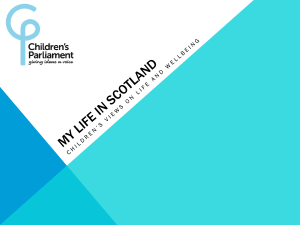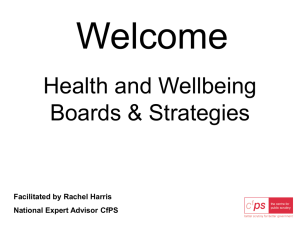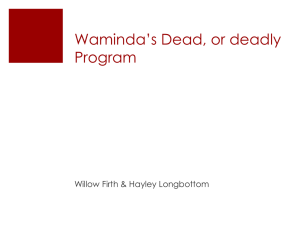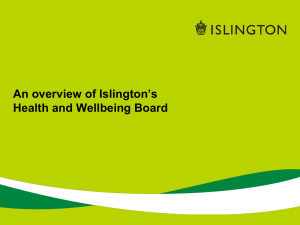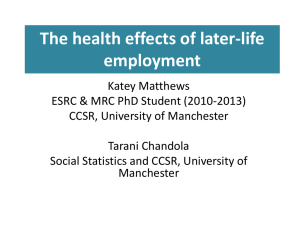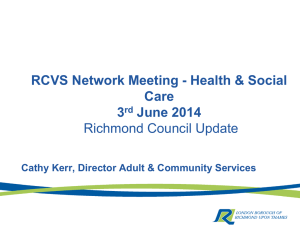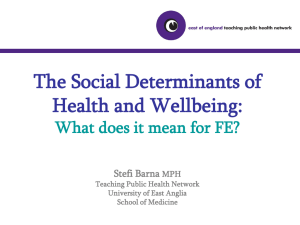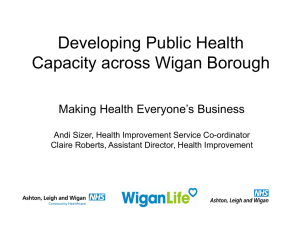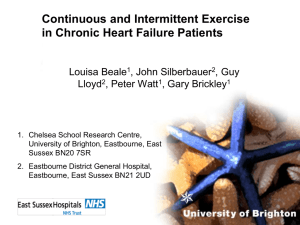Further back ground reading for assignments
advertisement
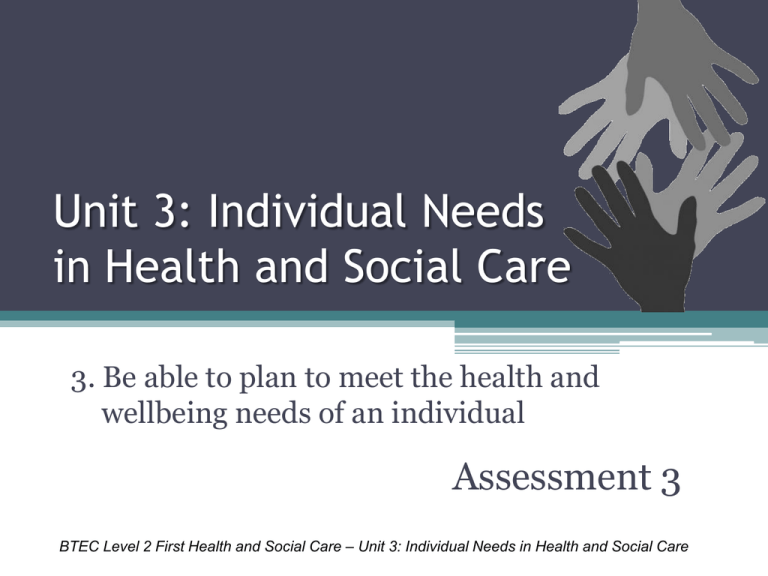
Unit 3: Individual Needs in Health and Social Care 3. Be able to plan to meet the health and wellbeing needs of an individual Assessment 3 BTEC Level 2 First Health and Social Care – Unit 3: Individual Needs in Health and Social Care My life: Plan for health • If you had to improve one thing about your health, what would it be? • How would you plan to make these changes? 3. Be able to plan to meet the health and wellbeing needs of an individual This section you will take part in: • Planning to meet the health and wellbeing needs of an individual • Producing a health plan Topics discussed in this section: • Everyday and health needs • Assessing the needs • Planning Key terms • Assessment– the on-going process of gathering, analysing and reflecting on evidence to make an informed decision • Confidential –information that should be kept secret. It has been entrusted only to the person to whom it has been communicated Everyday and health needs When producing a health plan think of: • PIES (including spiritual) Consider health factors such as: • Diabetes • Asthma • Emphysema, etc. Case study: Marie, Jonny and Colette Marie-58 yrs old Over the last few months she has noticed that she has put on weight. She used to weigh 53 kg but she now weighs 65 kg and feels very uncomfortable. Marie is certain that she needs to lose weight. Jonny- 19 yrs old Colette-25 yrs old Marie’s son. He drinks too much and he knows it. On Fri & Sat, he goes with friends, comes home late and feels bad on Sun & Mon. He’s tried ecstasy a few times; great while it lasts, and easy to get hold of, but he’s worried he might get used to taking it. He is pretty sure now that he needs to drink less and keep away from ecstasy. She has asthma and needs to have regular medication including an inhaler. She sometimes forgets to take it with her and recently was hospitalised after a severe asthma attack while she was out with friends. Colette knows that she must remember her medication. Choose one of these individuals Marie Think about all the PIESS needs that would be met if they carried out their plans towards better health Don’t forget, this is not just about physical health S Jonny Colette I P E S Working with individuals to meet their health and wellbeing needs Assess their needs & work together • Ask simple questions about: ▫ Their background ▫ Lifestyle ▫ Why do they want to make changes • Ask about: ▫ Age – how old are they (life stage) ▫ Preferences (for example, what kinds of exercise do they like, do they prefer morning or evening for a walk, etc.) Remember: you are working in a position of trust Confidentiality • Service providers have lots of confidential information about service users • This must be safe guarded and kept secure • Data Protection Act 1998 protects people’s rights to confidentiality no matter how it may be stored • You must be careful not to breach any rules of confidentiality • Confidentiality is very serious and must be respected at all times Confidentiality is important in health and social care Consequence will be… Service user might be… • Loss of trust • Less likely to say how he or she really feels or share a problem • Lower self-esteem • Likely to feel unvalued and as though they don’t matter • Insecurity • Feeling their property and personal safety is threatened • Discrimination • Treated differently by others If confidentiality and trust is broken; the consequences can be difficult to repair Confidentiality: there are times…. It can be appropriate to breach confidentiality: • If service users are at risk ▫ To themselves ▫ To others ▫ If they have broken or about to break the law There may be times when it might be necessary to pass information on to an appropriate colleague or authority ▫ If in doubt, always check with your manager/tutor Assessment • Why are age and preferences important when you start to carry out an assessment? • Why is confidentiality important when you are collecting information from or about an individual? How to assess a person’s needs so that a plan can be drawn up to meet these needs My life: How are you? • If you wanted to find out how healthy you are, what facts would you need to find out from your doctor? • If you wanted to find out about the health of a large sample of people, how would you do this? Physical and physiological measurements • Physical: to do with the body. This includes measures such as height and weight • Physiological: to do with the normal functions of the body. This means measures such as blood pressure, pulse or cholesterol levels • Rate: a measure of something compared with something else, such as litres per second or beats per minute • Diagnose: to identify a medical condition Aspects of health that can be measured Height/weight Blood pressure Temperature Resting pulse and recovery pulse rates after exercise Peak flow Measurable aspects of health Hip/waist ratio Cholesterol levels Liver function Blood glucose Body Mass Index (BMI) • A measure of the amount of fat in your body in relations to your height • BMI formula: BMIs for adults Adult Significance Less than 18.5 Underweight 18.5-24.9 Healthy weight 25-29.9 Overweight 30+ Obese Peak flow • Measure of the maximum rate (the expiratory flow rate) in litres per minute, at which air is expelled from the lungs when breathed out as hard as possible • Blowing into it, lips sealed firmly round the mouthpiece, causes a pointer to move to a certain point; peak flow can then be read off the scale. Do this three times and take the highest reading • Most common reasons for recording peak flow: ▫ Monitor asthma for medication effectiveness ▫ Diagnose lung problems by comparing the actual reading to expected score chart based on age and gender Peak flow chart of expected scores Expected normal scores of peak flow based on: • Age • Gender • Good health Blood pressure • Blood pressure: the pressure exerted by your blood against the walls of the arteries ▫ Measured in millimetres of mercury as two numbers ▫ Varies from person to person ▫ Normal blood pressure at rest: 140/90 • Top number: systolic pressure – maximum pressure in the arteries as the heart pumps blood out • Bottom number: diastolic pressure – the minimum blood pressure as the heart relaxes between beats High blood pressure is called hypertension • Can lead to stroke • Heart disease Low blood pressure is called hypotension • Can lead to dizziness • Can indicate a more serious problem such as Parkinson’s disease Pulse rate • Pulse rate measures how strongly the heart is beating • Force of the heart pumping blood around the arteries causes a pulsing sensation • Measured as beats per minute • At rest a healthy pulse in a young adult is around 70 beats per minute • What is meant by assessing needs? • Name three ways of collecting information to put together a person’s personal history • Explain how to actually measure three different measures of health This topic looks at ways to put together a health plan Key term: Targets – short and longer term challenges to help you meet your goal My life: A good plan? • Think of something you have done that needed planning, such as going on a holiday with a friend, doing a project at school or revising for exams. How did you set about drawing up a plan? • What made your plan work well? • What made your plan work less well? Planning: SMART targets • Specific –target must be clearly stated, such as lose one kilo in weight in one week or take a 30 minute walk twice a week-it is clear and cannot be misunderstood or used as an excuse • Measurable – it is too vague to say “eat more fruit”: an amount must be stated, so you can prove that you have met the target • Achievable –be possible to achieve the target; otherwise you might give up. Asking someone to give up smoking in a week or walk 3 miles each day for four days, may not be achievable • Realistic – must be able to do it. It is unrealistic to expect someone who is older and not very fit to run for 30 min a day • Time-related – there should be a deadline for reaching the target so progress can be assessed Action plan • Start by stating the problem to be tackled • Indicate what needs to be done to meet each target and by whom • Suggest alternatives; if things don’t work • Outline any resources needed to meet targets • Budget for the plan • Implement the plan • Monitor targets Monitor and review • Set SMART targets that can be monitored regularly • Amend plan if necessary to meet longer-term targets and goals • Review targets (may need to start over again) • Choose different targets to improve chances of success • Planning Cycle – the process of setting targets, reviewing them after a certain time, amending the plan with new targets, is called the planning cycle A simple plan: The Planning Cycle Set a SMART target and monitor regularly Review the Target Amend the Target GOAL The Planning Cycle Summary Mission or Target SMART targets Summary of the features of a plan • A statement outlining the health or wellbeing needs of the individual, based on an assessment of present health status through the use of physical measures of health and wellbeing ▫ May include a summary of factors leading to these needs and the expected benefits • SMART targets (short and long term) ▫ Strategies to meet targets with alternatives to overcome any obstacles • Regular monitoring and reviewing progress of targets • Strategies to maintain improvement in health and wellbeing Individual person SMART targets Long-term SMART targets Short-term Statement of individual’s health and wellbeing needs Assessment of present health status Use of physical measures Strategies to meet targets Including alternatives Summary of factors and expected benefits Regular monitoring & reviewing Features of a plan for health and wellbeing Strategies to maintain improvement to health and wellbeing Outline the health & wellbeing needs of the individual based on an assessment Sample Care plan for Ilsa Vinegars Date Need Aim Action Evaluation 22/04 Ilsa has hearing loss and has new hearing aids. She needs to be able to communicate with those around her. Ilsa to manage her own hearing aid including insertion, cleaning and checking batteries Jasmin to show Ilsa how to put her hearing aids in effectively and keep them clean and check the battery. By 26/06 Ilsa will be managing her hearing aid and will be able to take part in conversations, listen to the radio and watch television. This care plan shows how Ilsa’s hearing can be improved by management of her new hearing aid Models of support Advocacy Resources available Networking Theories Normalisation Empowerment Meeting Individual Needs Involvement of service users & carers Assessment of Needs Activities of daily living Holistic and person-centred approach to individual needs The Care Planning Cycle Health Care Social Services

